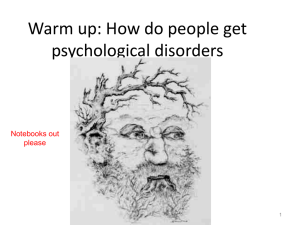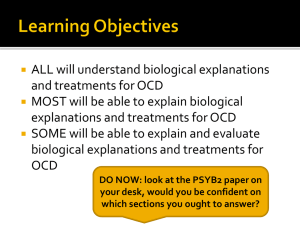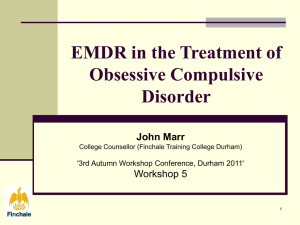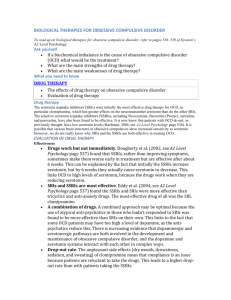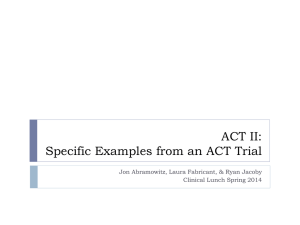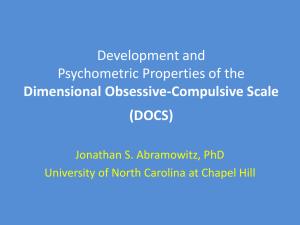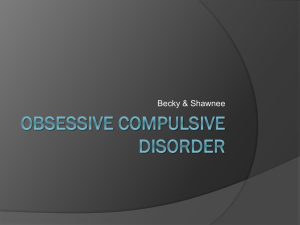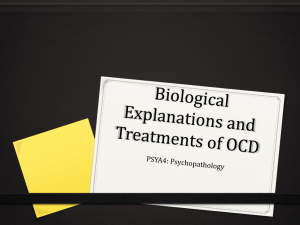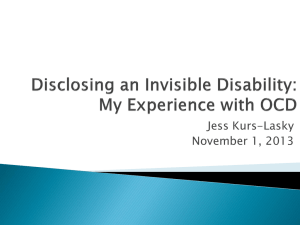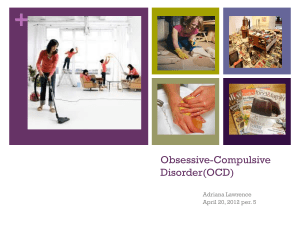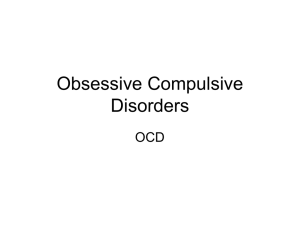Learning Objective: to explore biological treatments for OCD
advertisement
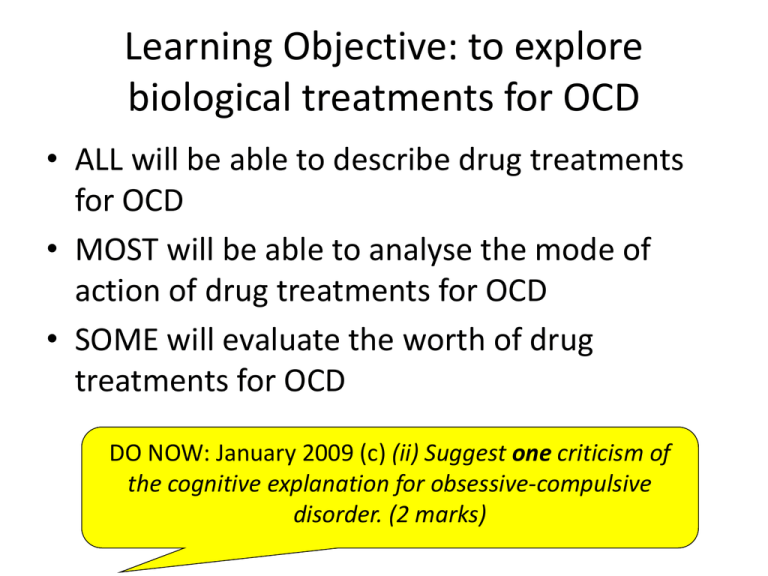
Learning Objective: to explore biological treatments for OCD • ALL will be able to describe drug treatments for OCD • MOST will be able to analyse the mode of action of drug treatments for OCD • SOME will evaluate the worth of drug treatments for OCD DO NOW: January 2009 (c) (ii) Suggest one criticism of the cognitive explanation for obsessive-compulsive disorder. (2 marks) FEEDBACK: MARK SCHEME January 2009 (c) (ii) Suggest one criticism of the cognitive explanation for obsessive-compulsive disorder. (2 marks) • 1 mark for criticism, 1 for elaboration of criticism. • Possible answer: • The cognitive approach focuses on internal mental processes as an explanation and ignores other possible causes such as social/biological factors. Learning Objective: to explore biological treatments for OCD • ALL will be able to describe drug treatments for OCD • MOST will be able to analyse the mode of action of drug treatments for OCD • SOME will evaluate the worth of drug treatments for OCD What do we know already about biological explanations of OCD? Which part of the biological explanation is drug treatment likely to focus on? Why? Biological treatments for OCD BOTH of the biological treatments we will cover for OCD focus on increasing the amount of serotonin at the synapse (the biochemical explanation) SSRIs are a group of anti-depressant medications which are the most widely prescribed drugs for anxiety disorders. SSRIs increase the levels of the neurotransmitter serotonin in the brain by preventing the reabsorption of serotonin at synapses (spaces between nerve cells). Because depression frequently accompanies OCD, SSRIs are particularly beneficial for this anxiety disorder. MAOIs are an older type of anti-depressant which are sometimes used for those who gain no benefit from SSRIs. They prevent MAO from destroying serotonin at the synapse. http://www.youtube.com/watch?v=l3FvOJExGCI You will watch the video and then add to your diagram to show how SSRIs and MAOIs work Evaluation: the good and the bad • (+)SSRIs are easily tolerated and are safe, even for older patients. They are not addictive and can be used in the long-term. • (+) Drug treatment is quicker and cheaper than psychological therapies • (-) SSRIs cause side effects (headaches, nausea, sexual dysfunction), there can be relapse when coming off the medication • (-) SSRIs take 4-12 weeks before any therapeutic effect is noticed, this, together with side effects, this can cause people to stop taking the medication • (-) MAOIs are effective but they are last in line to be used for treatment due to side effects e.g. weight gain, sexual dysfunction. • (-) A serious rise in blood pressure can occur when MAOIs are combined with foods containing the amino acid tyramine found in certain foods e.g. cheese, wine. • WHAT ELSE IS WRONG WITH JUST TAKING DRUGS TO STOP SYMPTOMS OF OCD? This week’s homework: January 2013 PPQ Discuss biological explanations of obsessive compulsive disorder (OCD). Refer to evidence in your answer. (10 marks) Mark Scheme: creating our recipe for success • • • • • • • • • AO1 Up to five marks for description of biological explanations of OCD. Credit can be awarded for any or all of the following explanations: Genetic explanation - some people are predisposed to develop the disorder as a result of inherited familial influence. Biochemical explanation – low levels of serotonin associated with anxiety; high levels of dopamine linked to compulsive behaviour/stereotypical movements. Physiological explanation - basal ganglia in the brain responsible for psychomotor functions, hypersensitivity of the basal ganglia may result in repetitive movements; linked to abnormality/excessive activity in the orbital frontal cortex. Maximum 1 mark for simply naming/listing explanations. Credit description of evidence up to two marks. Likely studies: McKeown and Murray (1987), Bellodi et al. (2001), Pauls et al. (1995), Rapoport and Wise (1988), Aylward et al. (1996). AO2 Up to five marks for discussion of biological explanations of OCD. Likely points include: the effectiveness of biological/drug therapies and how this supports the (biochemical) explanation eg antidepressants that increase serotonin levels reduce OCD symptoms in many patients; problem that not all sufferers respond to drug treatment; issue of causation; treatment fallacy; contradictory evidence in brain scan studies; alternative explanations for findings from family/twin studies such as shared environments; brain structural accounts tend to explain repetitive behaviour but not obsessional thoughts. Credit discussion of broader issues such as reductionism, determinism etc. Credit reasoned comparison with alternative explanations e.g. cognitive. Only credit evaluation of the methodology used in studies when made relevant to discussion of the explanation. Credit use of evidence. Maximum 6 marks if no evidence What did the examiner say – key mistakes made! • Question 27 • Most answers discussed two or three explanations. In some, key details, such as the ‘levels of serotonin’ linked to OCD, were inaccurate. • Some answers began to write about Selective Serotonin Reuptake Inhibitors (SSRI) as a treatment for OCD and the support for the ‘serotonin’ explanation, but got ‘sidetracked’ into describing different treatments rather than focusing back on the biological explanation. • Discussions of the basal ganglia were often well done, but there was occasional confusion between the ‘hyperactivity’ associated with this brain region, and the cognitive notion of ‘hypervigilance’. Learning Objective: to explore biological treatments for OCD • ALL what drug treatments exist for OCD? • MOST how do the drugs actually work, at the level of the synapse? • SOME what are the strengths and weaknesses of drug treatment? Where have you reached in your learning today? Which questions can you answer?
